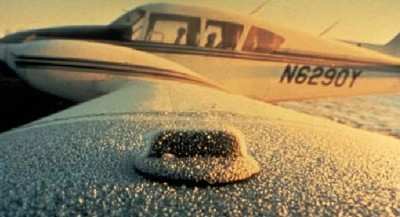Sun, Nov 05, 2006
Aero-Tips!
A good pilot is always learning -- how many times have you heard
this old standard throughout your flying career? There is no truer
statement in all of flying (well, with the possible exception of
"there are no old, bold pilots.")

Aero-News has called upon the expertise of Thomas P. Turner,
master CFI and all-around-good-guy, to bring our readers -- and us
-- daily tips to improve our skills as aviators. Some of them, you
may have heard before... but for each of us, there will also be
something we might never have considered before, or something that
didn't "stick" the way it should have the first time we memorized
it for the practical test.
Look for our daily Aero-Tips segments, coming each day to you
through the Aero-News Network.
Aero-Tips 11.05.06
You've recently read ANN's report on changes to
the approved procedure for "polishing" frost on airplane wings in
lieu of removing it completely before flight. The new guidance says polishing
frost is only approved if the specific airplane manufacturer
recommends an ice-polishing procedure to negate frost's adverse
effects -- a procedure that likely does not exist.

"Polishing" guidance
Federal Air Regulation 91.527(a) is the rule that tells us no
pilot may take off an airplane that has:
- Frost, snow, or ice adhering to any propeller, windshield, or
powerplant installation or to an airspeed, altimeter, rate of
climb, or flight attitude instrument system;
- Snow or ice adhering to the wings or stabilizing or control
surfaces; or
- Any frost adhering to the wings or stabilizing or control
surfaces, unless that frost has been polished to make it
smooth."
But FAR 91.527(a) applies only to large (maximum gross weight
over 12,500 pounds) and turbine-powered multiengine airplanes. For
the rest of us, FAR 91.7 (Civil Aircraft Airworthiness), 91.13
(Careless and Reckless Operation) and 91.103 (Preflight Action) are
the only guidance on taking off with a load of frost or ice. None
of these references specifically mention frost-contaminated wings,
and none permits "polishing" frost.
The FAA's Airplane Flying Handbook
advises:
"Ice and frost may be factors during the winter months. There is
no amount of ice safe for takeoff (emphasis added). Even a thin
layer of frost can have a dramatic effect on a wing's ability to
produce lift. The best solution for deicing is a heated
hangar."
Aero-tip of the day: Don't mess with unapproved
and ill-advised schemes to get around frost removal. Budget the
time (or the hangar rental) to remove frost completely before
attempting flight.
More News
Aero Linx: Model Aeronautical Association of Australia MAAA clubs are about fun flying, camaraderie and community. For over 75 years, the MAAA has been Australia’s largest fl>[...]
Touchdown Zone Lighting Two rows of transverse light bars located symmetrically about the runway centerline normally at 100 foot intervals. The basic system extends 3,000 feet alon>[...]
“Discovery and innovation are central to our mission at Virgin Galactic. We’re excited to build on our successful record of facilitating scientific experiments in subor>[...]
How To Get A Story On Aero-TV News/Feature Programming How do I submit a story idea or lead to Aero-TV? If you would like to submit a story idea or lead, please contact Jim Campbel>[...]
Student Pilot Reported That During Rotation, “All Of A Sudden The Back Of The Plane Kicked To The Right..." Analysis: The student pilot reported that during rotation, “>[...]
 ANN's Daily Aero-Linx (05.02.24)
ANN's Daily Aero-Linx (05.02.24) ANN's Daily Aero-Term (05.02.24): Touchdown Zone Lighting
ANN's Daily Aero-Term (05.02.24): Touchdown Zone Lighting Aero-News: Quote of the Day (05.02.24)
Aero-News: Quote of the Day (05.02.24) ANN FAQ: Contributing To Aero-TV
ANN FAQ: Contributing To Aero-TV NTSB Final Report: Cirrus Design Corp SR20
NTSB Final Report: Cirrus Design Corp SR20




